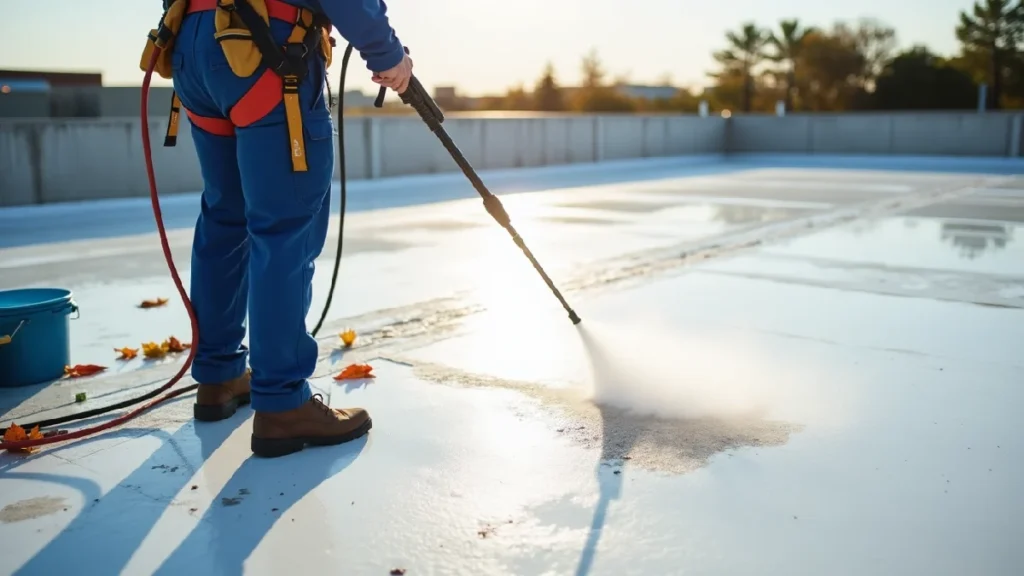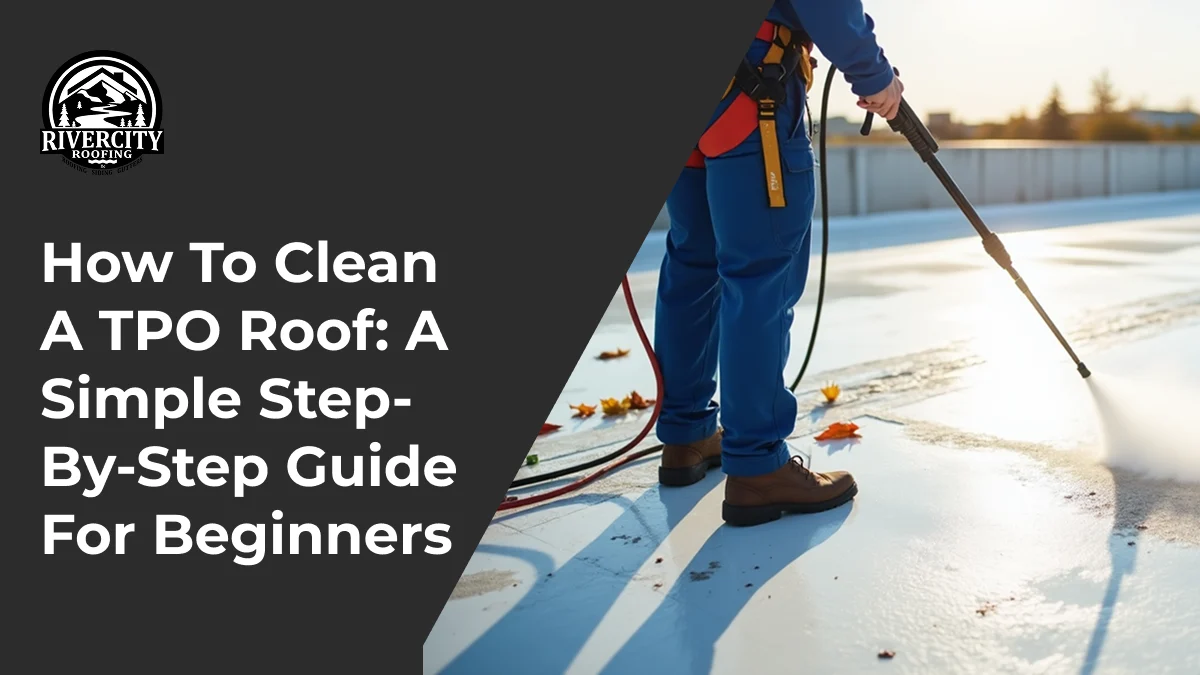Did you know TPO roofs need a thorough cleaning after each major season change, about four times yearly?
These durable roofing systems last 15-20 years when properly maintained and have become popular because they offer affordable solutions and energy efficiency. TPO roofs can reduce your roof’s temperature by up to 50 degrees compared to traditional materials. But they attract rainwater, leaves, and branches that can lead to mold and pest problems if you don’t maintain them properly.
Regular cleaning of TPO roof surfaces is a vital part of maintenance. The best part? Professional roof cleaning starts at just $250 – which costs nowhere near what you’d pay to clean other hard-to-reach roofs. In this How to Clean a TPO Roof guide we will walk you through everything about keeping your TPO roof clean and in great shape, whether you plan to do it yourself or hire professionals.
How to Clean a TPO Roof – Common Problems That Require Cleaning
TPO roofs are built to last, but they face many challenges that need regular cleaning. You’ll maintain your roof’s integrity and make it last longer by understanding these problems.
Dirt and debris build-up creates the biggest headache for TPO roofing systems. This buildup can become a breeding ground for mold, mildew, and algae that eat into the roofing material. Your roof’s structure weakens as these organisms spread. The accumulated matter also feeds potential algae growth.
Flat roof systems often struggle with drainage. Water pools easily on the surface because of the low pitch, and dirt tends to collect there. The standing water weakens TPO material and breaks down seams. This damage leads to leaks, mold growth, and other serious problems.
A dirty TPO surface loses its power to work as a solar reflective membrane, which is really troubling. Light-colored TPO roofs should reflect UV rays to save energy during summer. Dirt-covered surfaces cut this benefit drastically and shorten your roof’s life.
Chemical exposure poses another major challenge. TPO membranes soak up greases and oils, which leave permanent stains. The roof weathers faster from acid exposure, while strong acids, oxidizers, and most strong bases damage roofing membranes of any type.
TPO resists tears and impacts well but can still get punctured. These maintenance steps help prevent problems:
- Remove dirt, debris, and overhanging tree branches
- Clean gutters to prevent clogs and water pooling
- Wash the roof surface regularly to maintain its reflective properties
Your TPO roof’s cleaning needs depend on your area’s climate, rain levels, roof pitch angle, and local dust and wind conditions. A regular maintenance schedule helps you avoid structural damage, inventory loss, operational downtime, and mold growth.

Free Roof Inspections. Fast. Reliable.
Is your roof ready to weather the storm? Dont risk property damage. Our free roof inspections provide expert analysis to identify potential issues before they become costly problems.
Preparing for Your TPO Membrane Cleaning Project
Good preparation lays the groundwork for successful TPO roof cleaning. I need to keep myself safe and protect the roof during the entire process.
Safety First – TPO membrane gets very slippery with water and cleaning solutions. Stick to all fall safety rules and stay away from wet or soapy spots. A good grip on the ladder rungs instead of side rails gives better stability.
Protecting Vulnerable Areas – You must protect these areas before starting:
- Low curbs and base flashings that might let water seep through
- Surrounding vegetation from cleaning solution runoff
- Drainage points to prevent clogging
- Seams and transitions between the membrane and other roof parts
Gathering Equipment – You will need these items to clean effectively:
- A soft-bristle push broom or long-handled brush
- A low-pressure power washer (under 2,000 PSI)
- TPO-safe cleaning solution
Choosing the Right Cleaner – Most manufacturers suggest specific products for TPO roofs. Mild, non-abrasive household detergents work best. Simple Green, Dawn dish detergent, or Murphy’s Oil soap are good options according to sources. Products with petroleum, bitumen, or strong chemicals can damage TPO membranes, so avoid them.
Pre-Cleaning Steps – You will need to sweep all visible debris off the surface first. This prevents scratches on the membrane during washing. Breaking the roof into smaller sections helps me clean systematically. Small sections make it easier to clean and rinse properly.
Also Checkout: PVC vs TPO Roofing: Which Lasts Longer? [2025 Guide]
My systematic approach includes rinsing with low pressure first. Then apply the cleaning solution and scrub gently with a soft brush. A final rinse follows, always pushing water toward the drains. Check for any damage to seams, flashings, or the membrane after cleaning.
Trained contractors know TPO roofing systems well, so professional cleaning is your best option whenever possible.
Professional vs. DIY TPO Roof Cleaning
Property owners often struggle to decide between DIY cleaning and hiring professionals for their dirty TPO roof. This choice affects both their budget and their roof’s durability. Safety is also a big concern.
Professional roof cleaning typically costs between $300 and $620. Most homeowners pay around $450. DIY might look cheaper at first glance. The costs add up fast though. You’ll need to buy cleaning solutions and safety equipment. If you don’t own ladders and other tools, your upfront costs could be substantial.
Safety stands out as the biggest reason people hire Roofing professionals. Roof work comes with real fall risks. These risks get worse when cleaning solutions make surfaces slippery. Professional cleaners come prepared with training, safety equipment, and insurance that protects them and your property.
Professional expertise makes a vital difference. TPO roofing experts know:
- The right way to clean without damaging the membrane
- Which products work safely with TPO materials
- How to spot potential problems during cleaning
- The correct low-pressure washing techniques (under 1200 PSI)
Professional services bring more benefits to the table:
- They catch small issues before they become expensive repairs
- They use eco-friendly, biodegradable cleaning solutions
- Many offer warranties (some with 2-year clean roof guarantees)
- They provide preventative treatments that keep your roof cleaner longer
Clean TPO roofs maintain their reflective properties and energy efficiency better. Regular professional maintenance helps your roof last beyond its expected 15-20 year lifespan.
DIY cleaning might seem like a money-saver at first. Most TPO roof manufacturers and experts recommend professional cleaning to avoid damage and get the best results.
Maintaining Your TPO Roof Between Cleanings
Your TPO roof’s lifespan depends on regular maintenance between scheduled cleanings. Good care will substantially reduce potential problems and help your roof perform better over the years.
Bi-annual inspections are the foundations of TPO roof maintenance that works. Schedule these in spring and fall, and check your roof after severe weather events. Early detection helps you catch small issues before they turn into big, expensive problems. Commercial buildings need quarterly inspections to keep the roof in top shape.
You need to remove debris between professional cleanings. Leaves, branches, and dirt can trap moisture and damage your TPO membrane when they pile up. Make it a habit to clear:
- Fallen leaves and branches
- Dirt buildups, especially near drainage areas
- Any potential food sources for birds and pests
Your flat TPO roof needs special attention to drainage. Water pooling can damage the membrane when left unchecked. Regular cleaning of gutters and drainage systems prevents water from backing up onto the roof surface.
Flashing inspection is a vital part of maintenance. Look for signs of wear or separation around leak-prone areas during your regular checks. Small repairs might get pricey at $200-$500, but fixing these issues quickly prevents bigger damage.
High-traffic areas need walkway pads, especially around HVAC units and equipment that needs frequent maintenance. These pads shield your TPO membrane from punctures and wear caused by foot traffic.
Regular trimming of overhanging tree branches reduces debris on your roof. This simple task prevents both debris buildup and storm damage.
A clean TPO roof reflects heat better and improves your building’s energy efficiency. Regular maintenance between professional cleanings helps preserve these benefits. Your roof can last beyond its typical 15-20 year lifespan with proper care.

Conclusion
TPO roofs are a smart investment for property owners, but their lifespan depends on how well you maintain and clean them. A clean roof keeps its reflective properties and helps streamline processes while preventing damage that can get pricey due to debris buildup.
Safety comes first with TPO roof maintenance. DIY cleaning might seem like an economical solution, but professional services are a great way to get specialized knowledge, equipment and insurance protection for both the roof and property owner. These professionals know the exact cleaning requirements that help TPO membranes work at their best.
Regular upkeep between cleanings plays a crucial role in extending the roof’s life beyond 15-20 years. Basic maintenance like removing debris, checking drainage systems and scheduling inspections stops small problems from becoming major headaches. Good care and scheduled cleaning ensure TPO roofs deliver lasting benefits of durability, energy savings and value throughout their service life.


